Themed collection Materials for Detection

Nanomaterials for ultrasensitive electrochemical nucleic acids biosensing
Electrochemical detection of biomolecular analytes is a promising approach for the development of new clinical diagnostics; this feature article discusses the significant improvements that have been made in this field when nanomaterials are used to construct nucleic acids sensors.

J. Mater. Chem., 2009,19, 3127-3134
https://doi.org/10.1039/B814569E
Functional nanomaterial-based amplified bio-detection strategies
We review recent advances and applications of functional nanomaterial-based amplification strategies in bio-detection assays. Enzymatic and non-enzymatic amplification strategies using various nanomaterials' structures and properties are summarized, and basic principles, advantages, limitations and perspectives of these amplification strategies are discussed.
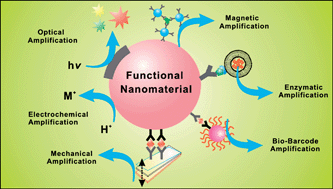
J. Mater. Chem., 2009,19, 2107-2117
https://doi.org/10.1039/B816690K
Functional DNA directed assembly of nanomaterials for biosensing
This review summarizes recent progress in the development of biosensors by integrating functional DNA molecules with different types of nanomaterial, including metallic nanoparticles, semiconductor nanoparticles, magnetic nanoparticles, and carbon nanotubes.
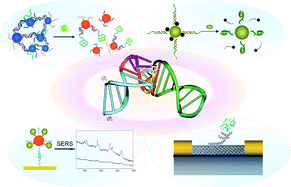
J. Mater. Chem., 2009,19, 1788-1798
https://doi.org/10.1039/B813939C
Highly encoded one-dimensional nanostructures for rapid sensing
Over conventional microarrays in multiplex bioassays, one-dimensional barcode arrays show potential advantages as a novel assay format for genomics and proteomic research as well as rapid and sensitive diagnostics.
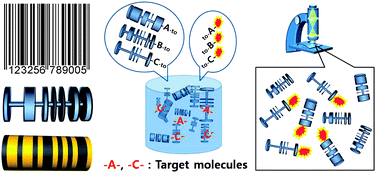
J. Mater. Chem., 2009,19, 1381-1389
https://doi.org/10.1039/B814408G
Amphiphilic nanoassemblies for the detection of peptides and proteins using fluorescence and mass spectrometry
The utility of amphiphilic nanoassemblies in the sensing of proteins and peptides is reviewed. The article is specifically focused on fluorescence and mass spectrometry as transducers.

Analyst, 2009,134, 635-649
https://doi.org/10.1039/B818484D
Development of a piezoelectric sensor for the detection of methamphetamine
A piezoelectric sensor capable of measuring 1 µg mL−1 of methamphetamine was successfully developed using molecularly imprinted polymers (MIPs) as a receptor and exploring different protocols for the polymer immobilisation.

Analyst, 2009,134, 1565-1570
https://doi.org/10.1039/B819351G
Selective detection of hexachromium ions by localized surface plasmon resonance measurements using gold nanoparticles /chitosan composite interfaces
A transmission localized surface plasmon interface based on a chitosan matrix with incorporated gold nanoparticles was used for the selective removal of hexavalent chromium from aqueous solutions.
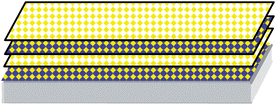
Analyst, 2009,134, 881-886
https://doi.org/10.1039/B817140H
Design of liposome-based pH sensitive nanoSPIN probes : nano-sized particles with incorporated nitroxides
Liposome-based nanoSPINs were designed for EPR applications as pH probes. The phospholipid membrane with incorporated gramicidin A showed permeability to a small analyte, H+, while protecting the entrapped nitroxide from biological reductants.
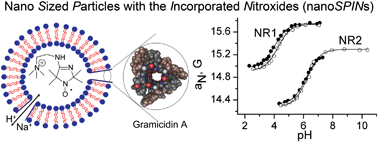
Analyst, 2009,134, 904-910
https://doi.org/10.1039/B818184E
Detection of
drugs and their metabolites in dusted latent fingermarks by mass spectrometry
This paper describes for the first time how SALDI-TOF-MS can be used to identify contact with or use of illicit drugs in latent fingermarks pre-dusted with a new dusting agent.
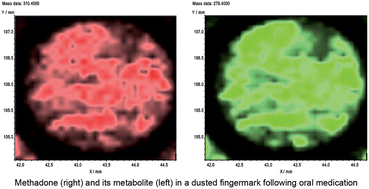
Analyst, 2009,134, 701-707
https://doi.org/10.1039/B813957C
Selective detection of dopamine using a combined permselective film of electropolymerized (poly-tyramine and poly-pyrrole-1-propionic acid) on a boron-doped diamond electrode
An effective and robust electrochemical approach for the selective detection of dopamine using a boron-doped diamond electrode is described.
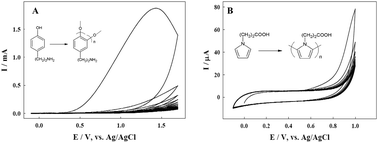
Analyst, 2009,134, 519-527
https://doi.org/10.1039/B814317J
Immobilisation of proteins at silicon surfaces using undecenylaldehyde: demonstration of the retention of protein functionality and detection strategies
We describe a simple method for the covalent attachment of proteins to unoxidized silicon surfaces and demonstrate the use of these materials for electronic detection of protein interactions.
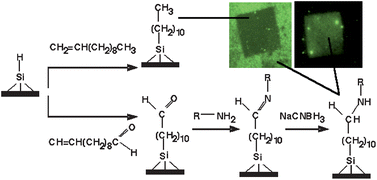
Analyst, 2009,134, 593-601
https://doi.org/10.1039/B813328J
SERRS coded nanoparticles for biomolecular labelling with wavelength-tunable discrimination
The preparation and use of tri-functional linkers for surface complexation to both gold and silver nanoparticles is reported and demonstrates the potential of SERRS functionalised nanoparticles for multiple, simultaneous monitoring of excitation events.

Analyst, 2009,134, 549-556
https://doi.org/10.1039/B813821D
Development of a silica -based double-network hydrogel for high-throughput screening of encapsulated enzymes
A new silica–organic hybrid hydrogel was prepared to enable biomolecule encapsulation. The new hydrogel had increased mechanical strength, and biomolecules within the hydrogel also exhibited improved activity and durability.

Analyst, 2009,134, 577-581
https://doi.org/10.1039/B813936A
Visible and near-infrared chemosensor for colorimetric and ratiometric detection of cyanide
A chemosensor system can quantitatively determine cyanide at micromolar concentrations. The sensory signals include color change and fluorescence quenching and enhancement in both the visible and near-infrared spectral regions.
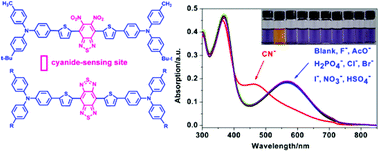
J. Mater. Chem., 2009,19, 522-530
https://doi.org/10.1039/B813478B
Direct and label-free detection of cholic acid based on molecularly imprinted photonic hydrogels
A new approach based on molecularly imprinted photonic hydrogels (IPHs) was developed, by which direct, sensitive and label-free detection of cholic acid can be achieved without any derivatization treatment and expensive instruments.

J. Mater. Chem., 2008,18, 5452-5458
https://doi.org/10.1039/B811189H
Polymerization of a boronate -functionalized fluorophore by double transesterification: applications to fluorescence detection of hydrogen peroxide vapor
A stable polyboronic ester capable of detecting both vapour- and solution-phase hydrogen peroxide at the ppb level by a turn-on fluorescence response. The highly selective detection method may be used for the detection of organic-based explosives such as TATP and HMTD.

J. Mater. Chem., 2008,18, 5134-5141
https://doi.org/10.1039/B809674K
Silver nanocluster-based fluorescent sensors for sensitive detection of Cu(II)
Water-soluble fluorescent silver nanoclusters have been successfully applied to develop new fluorescent sensors for sensitive and selective detection of Cu2+

J. Mater. Chem., 2008,18, 4636-4640
https://doi.org/10.1039/B810409C
A facile and efficient method for rapid detection of trace nitroaromatics in aqueous solution
A novel optical chemosensor based on ZnO doped mesoporous silica films has been developed for the quantitative and qualitative determination of nitroaromatic contaminants in aqueous solutions.

J. Mater. Chem., 2008,18, 4426-4432
https://doi.org/10.1039/B802655F
Calix[4]arenes immobilized in a cellulose-based platform for entrapment and detection of NOx gases
Solid materials made by dissolution of calix[4]arenes and cellulose in an ionic liquid followed by casting into a membrane can be used for the reversible colorimetric detection of NOx.
![Graphical abstract: Calix[4]arenes immobilized in a cellulose-based platform for entrapment and detection of NOx gases](/en/Image/Get?imageInfo.ImageType=GA&imageInfo.ImageIdentifier.ManuscriptID=B803289K&imageInfo.ImageIdentifier.Year=2008)
J. Mater. Chem., 2008,18, 4050-4055
https://doi.org/10.1039/B803289K
Nanocomposite membranes as highly selective and sensitive mercury(II) detectors
A new nanocomposite membrane for the selective detection of trace amounts (down to the ppb level) of mercury(II) ions in water was prepared by filtering nanoparticles of a fluorophoric mercury(II) detecting molecule dispersed in water through a nanopore size cellulose membrane.

J. Mater. Chem., 2008,18, 1997-2002
https://doi.org/10.1039/B800708J
About this collection
Welcome to the Journal of Materials Chemistry and Analyst joint web theme on Materials for Detection.

Guest Editor: Professor Charles Martin, University of Florida
The Guest Editor of this web theme is Professor Charles Martin, University of Florida, USA. This theme explores all aspects of novel materials for bio- and chemosensing applications, ranging from peptide and protein detection to sensing of environmental pollutants.
Articles included in this web theme issue appear in regular issues of Journal of Materials Chemistry and Analyst.